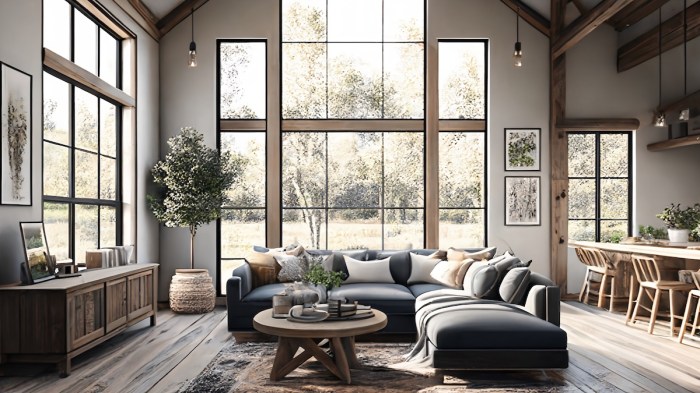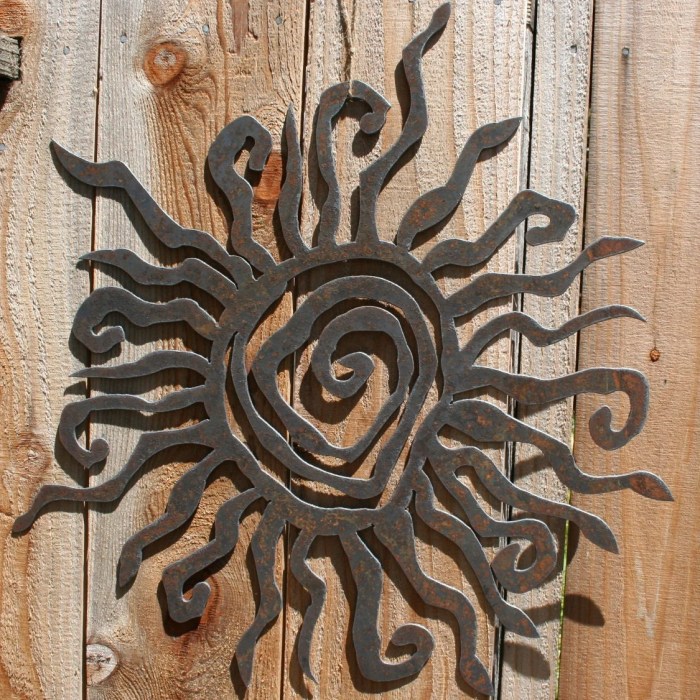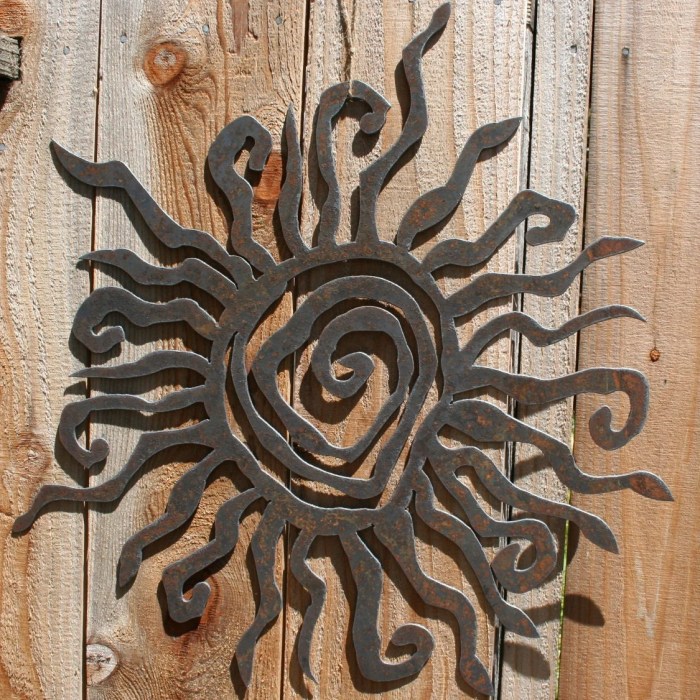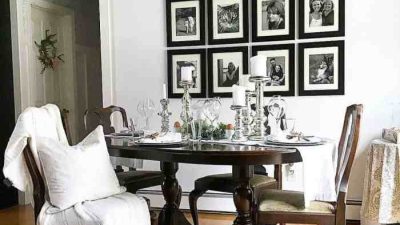Defining Rustic Farmhouse Style

Rustic farmhouse outdoor decor blends the charm of rural life with the comfort and functionality of a modern home. It’s a style that evokes feelings of warmth, simplicity, and connection to nature, making it a popular choice for creating inviting outdoor spaces. This style isn’t just a trend; it’s a reflection of a desire for authenticity and a retreat from the fast-paced modern world.Rustic and farmhouse styles, while often used interchangeably, have subtle differences.
Rustic emphasizes natural, unrefined elements – think rough-hewn wood, weathered stone, and reclaimed materials. Farmhouse, on the other hand, incorporates these rustic elements but adds a touch of refined elegance, often seen in painted furniture, softer textiles, and a more curated aesthetic. The blend of these two styles creates a unique look that’s both cozy and sophisticated.
Core Elements of Rustic Farmhouse Outdoor Decor
The core elements of rustic farmhouse outdoor decor revolve around natural materials and a sense of casual elegance. Key features include weathered wood furniture, such as reclaimed barn wood tables and chairs; stone or brick accents in pathways, fire pits, or retaining walls; the incorporation of natural textures like woven rugs, sheepskin throws, and metal accents with a slightly aged patina.
Rustic farmhouse outdoor decor is all about that cozy, lived-in feel. Finding the perfect pieces to complete your charming outdoor space can be a delightful adventure! Check out Hobby Lobby’s amazing selection for inspiration; you can find great ideas at their website for outdoor wall decor hobby lobby to get started. Then, add those special touches, like vintage signs or weathered planters, to really bring your rustic farmhouse vision to life.
Plants and flowers in rustic pots and containers further enhance the overall aesthetic, creating a sense of organic beauty. Lighting plays a crucial role, with options like string lights, lanterns, and outdoor sconces adding warmth and ambiance to the space.
Key Differences Between Rustic and Farmhouse Styles and Their Blend
While both styles share a love for natural materials, rustic leans towards a more rugged and unrefined appearance. Think rough textures, unfinished wood, and a slightly more haphazard arrangement of elements. Farmhouse style, while still utilizing natural materials, strives for a more polished and intentional look. Think carefully chosen pieces of furniture, a cohesive color palette, and a sense of order and balance.
The blend of the two seamlessly merges the raw beauty of rustic with the curated charm of farmhouse, resulting in a space that is both inviting and stylish.
Common Color Palettes in Rustic Farmhouse Outdoor Decor
Rustic farmhouse outdoor decor utilizes color palettes that complement the natural elements found within the style. Neutral tones are prevalent, with variations in shades of beige, gray, brown, and cream forming the foundation. These are often accented with pops of color inspired by nature, such as muted greens, blues, and rusty oranges. Think of the colors found in a weathered barn or a blooming wildflower meadow.
The use of these colors creates a harmonious and calming atmosphere. For example, a gray stone patio might be accented with terracotta pots filled with lavender and sage.
Comparison of Three Rustic Farmhouse Outdoor Styles, Rustic farmhouse outdoor decor
The following table compares and contrasts three different interpretations of rustic farmhouse outdoor decor:
| Style | Furniture | Color Palette | Overall Vibe |
|---|---|---|---|
| Modern Rustic | Clean lines, minimalist design, natural wood with a modern finish | Neutral base with pops of bold, saturated colors | Sophisticated, minimalist, yet still cozy |
| Traditional Rustic | Heavily weathered wood, antique pieces, possibly repurposed items | Muted earth tones, browns, creams, and greens | Warm, inviting, and nostalgic |
| Shabby Chic Rustic | Distressed painted furniture, lace accents, vintage finds | Pastels, creams, whites, with hints of rose or blue | Romantic, delicate, and charming |
Materials and Textures

Rustic farmhouse outdoor decor relies heavily on a carefully curated selection of materials and textures to achieve its signature blend of warmth, comfort, and natural beauty. The interplay between these elements is key to creating a space that feels both inviting and authentically rustic. This interview will explore the most common materials and how their textures contribute to the overall aesthetic.
Common Materials in Rustic Farmhouse Outdoor Decor
The foundation of rustic farmhouse style outdoors is built upon a selection of materials that evoke a sense of timelessness and connection to nature. Wood, stone, and metal are the cornerstones, each offering unique visual and textural qualities. Wood, often reclaimed or weathered, provides a sense of history and warmth. Stone, whether it’s rough-hewn flagstone or smooth river rock, lends a sense of permanence and grounding.
Metal, frequently wrought iron or galvanized steel, adds a touch of industrial charm that complements the natural elements. These materials, used individually or in combination, contribute to the overall aesthetic.
Texture and its Contribution to the Overall Aesthetic
Texture is paramount in achieving the desired rustic farmhouse look. The rough-hewn surface of a reclaimed wood table contrasts beautifully with the smooth, cool feel of a stone pathway. The aged patina of wrought iron furniture adds a layer of visual interest, while the soft texture of a woven rug placed on a patio adds a touch of comfort.
This interplay of contrasting and complementary textures creates visual depth and prevents the space from feeling monotonous. For instance, the starkness of a smooth stone wall can be softened by the addition of climbing vines with their varied textures of leaves and stems. The contrast of textures creates a dynamic and engaging outdoor space.
Incorporating Natural Elements
The successful integration of natural elements is crucial for capturing the essence of rustic farmhouse style. Plants, flowers, and wood slices are readily incorporated to enhance the overall design. Consider using climbing roses or ivy to soften the edges of a stone wall or fence. Potted herbs and flowering plants add bursts of color and life, while strategically placed wood slices can serve as rustic coasters or decorative accents.
Think about using a collection of different sized terracotta pots filled with various succulents for a low-maintenance, yet visually appealing, arrangement. The natural forms and textures of these elements create a sense of harmony with the surrounding environment.
Mood Board: A Visual Representation of Textures and Materials
Imagine a mood board featuring several key elements. A large, rustic wooden sign with slightly peeling paint sits at the top, representing the weathered charm of reclaimed wood. Below, a swatch of smooth, grey flagstone represents the solidity and permanence of natural stone. Next to it, a piece of dark, wrought iron – perhaps a decorative fence section – shows the contrast of metal.
Smaller elements include a small cluster of dried wildflowers, showcasing the organic textures of natural flora. A small section of woven fabric, perhaps a burlap-like material, adds a tactile element of warmth and rusticity. Finally, a close-up of a rough-hewn wood slice highlights the natural variations in wood grain. The overall effect aims for a harmonious balance between contrasting textures, creating a cohesive and visually appealing rustic farmhouse aesthetic.
The visual impact is one of warmth, natural beauty, and inviting charm. The different textures and materials work together to create a space that feels both lived-in and carefully curated.
Furniture and Seating

Choosing the right outdoor furniture is crucial for creating a welcoming and functional rustic farmhouse space. The pieces you select should complement your existing décor while providing comfortable seating and durable performance in various weather conditions. The key is to strike a balance between aesthetic appeal and practical considerations.
Types of Outdoor Furniture Suitable for Rustic Farmhouse Style
Three types of outdoor furniture particularly well-suited for a rustic farmhouse aesthetic are: wicker, wood, and metal furniture with a weathered or distressed finish. Wicker pieces, often made from rattan or wicker, offer a lightweight yet durable option that readily complements the relaxed, natural feel of a farmhouse setting. Wooden furniture, especially pieces crafted from reclaimed wood or materials with a natural, unfinished look, exude a sense of warmth and authenticity.
Metal furniture, particularly wrought iron or steel with a powder-coated finish that mimics rust or aged patina, adds a touch of rustic charm and durability.
Importance of Durable and Aesthetically Pleasing Furniture
Selecting outdoor furniture that is both durable and aesthetically pleasing is paramount. Durability ensures the furniture withstands the elements – sun, rain, and temperature fluctuations – maintaining its structural integrity and appearance over time. Aesthetically pleasing furniture enhances the overall look and feel of the outdoor space, contributing to a cohesive and inviting atmosphere. Investing in high-quality, durable furniture ultimately saves money in the long run by reducing the need for frequent replacements.
For example, a high-quality teak wood table will last for decades with proper maintenance, whereas a cheaper, less durable option may need replacing within a few years.
Furniture Arrangements for Different Outdoor Spaces
Furniture arrangements should be tailored to the specific outdoor space. A patio might benefit from a comfortable seating group centered around a fire pit or coffee table, encouraging conversation and relaxation. A porch, often narrower, might be best suited for a pair of rocking chairs or a bench, providing a tranquil spot to enjoy the outdoors. A larger deck might accommodate a dining set, allowing for outdoor meals and gatherings.
The arrangement should also consider the flow of traffic and the available space to ensure ease of movement and comfortable seating.
Examples of Furniture Pieces and Placement Suggestions
- Reclaimed Wood Dining Table: Material: Reclaimed wood; Style: Rustic; Placement: Deck or large patio. This substantial table provides a focal point for outdoor dining and gatherings. Imagine a large, weathered oak table with visible grain and character marks, capable of seating six to eight people comfortably.
- Wicker Rocking Chairs: Material: Wicker; Style: Relaxed; Placement: Porch or patio. These chairs offer comfortable seating and a touch of classic charm, perfect for relaxing and enjoying the view.
- Metal Bistro Set: Material: Wrought iron with a distressed finish; Style: Simple, elegant; Placement: Patio or small deck. This compact set, comprising a small table and two chairs, is ideal for intimate settings and smaller spaces. The aged metal finish adds to the rustic aesthetic.
- Wooden Adirondack Chairs: Material: Cedar or redwood; Style: Classic; Placement: Deck, patio, or lawn. These iconic chairs are comfortable, durable, and perfectly suited to a rustic farmhouse setting, adding a touch of timeless style. The natural wood grain complements the overall aesthetic.
FAQ Explained: Rustic Farmhouse Outdoor Decor
What is the difference between rustic and farmhouse styles?
Rustic emphasizes raw, natural materials and a slightly rougher, more aged look. Farmhouse style is cleaner and often incorporates more white or light colors, with a focus on functionality and comfort.
How can I make my rustic farmhouse outdoor space weather-resistant?
Choose weather-resistant materials like treated wood, weatherproof fabrics, and rust-resistant metals. Consider adding protective coatings to furniture and accessories.
What are some budget-friendly ways to incorporate rustic farmhouse decor?
Repurpose old items, use DIY projects (like making planters from reclaimed wood), and shop at flea markets or antique stores for unique and affordable pieces.
How do I maintain a rustic farmhouse outdoor space?
Regular cleaning, occasional repainting or sealing of wood, and seasonal maintenance of plants are key to preserving the beauty and longevity of your space.










